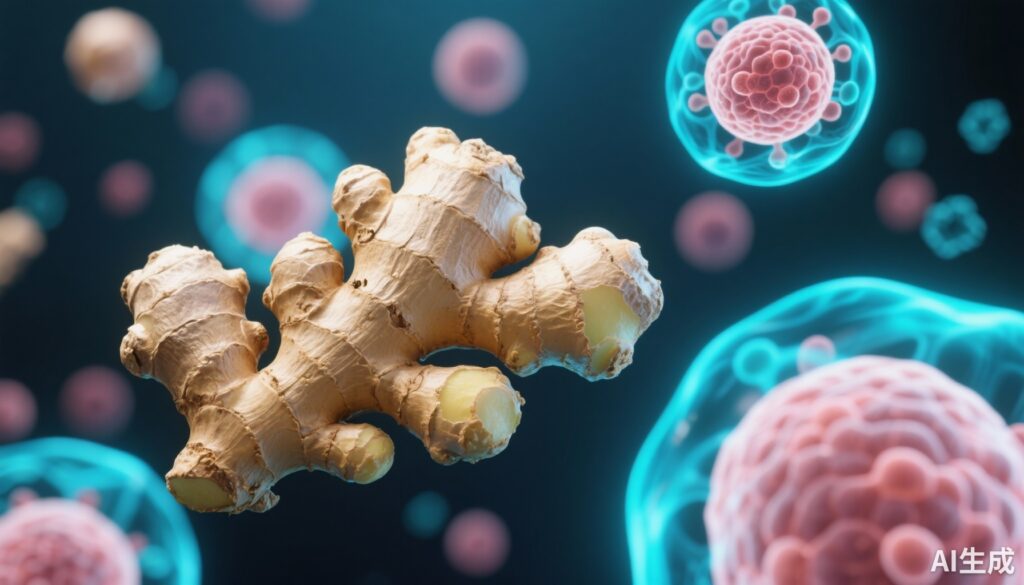Introduction: Ginger — From Kitchen Staple to Potential Anti-Aging Agent
Ginger has long been a humble yet beloved ingredient in kitchens worldwide, cherished for its warm, spicy aroma and its ability to elevate flavors in dishes from soups to steamed fish. Yet, recent scientific reports have cast ginger in a new light, suggesting it might not only warm the palate but also hold keys to longevity.
The United States National Institute on Aging (NIA) recently published a study in the journal PLOS ONE revealing that a compound found in ginger, known as gingerenone A, may clear up to 50% of aged, dysfunctional cells within just two days under laboratory conditions. This discovery sparked excitement among health enthusiasts eager to harness ginger’s potential to strengthen the body and slow aging. But how much of this excitement is justified by scientific evidence?
What Are Senescent Cells and Why Do They Matter in Aging?
Aging at the cellular level involves the accumulation of senescent cells—cells that have stopped dividing and no longer function properly. These cells secrete a range of harmful molecules termed the senescence-associated secretory phenotype (SASP), which includes pro-inflammatory cytokines, growth factors, and proteases. SASP factors exacerbate tissue dysfunction and accelerate aging in surrounding cells.
Because senescent cells behave like “zombie cells,” lingering in tissues without dying, they contribute significantly to age-related diseases and functional decline. Eliminating these cells has emerged as a promising strategy for combating age-related deterioration.
Scientific and Clinical Evidence: Can Ginger’s Gingerenone A Really Clear Senescent Cells?
In the study led by Dr. Luigi Ferrucci of the NIA, researchers isolated senescent human fibroblasts derived from bone marrow and exposed them to 20 micromolar (μM) concentrations of gingerenone A. After 48 hours, they observed a 50% reduction in senescent cell count alongside a marked increase in the cells’ proliferative capacity. Dr. Ferrucci likened this effect to rejuvenating cells physiologically resembling those of a 60-year-old to the activity level typical of a 30-year-old within two days.
Biologically, gingerenone A exerts its senolytic effect—meaning it selectively induces death in senescent cells—through mechanisms that require further elucidation but potentially involve modulation of mitochondrial function and anti-inflammatory pathways.
Beyond gingerenone A, ginger contains other bioactive compounds such as gingerols, shogaols, and zingerone, which exhibit antioxidant, anti-inflammatory, and antimicrobial properties. These contribute broadly to health but their direct anti-aging impact via senescence clearance remains less defined.
Limitations and Real-World Considerations
While laboratory findings are promising, translating them into practical anti-aging interventions faces hurdles. The key challenge lies in the concentration and stability of gingerenone A in fresh ginger. Studies show that gingerenone A accounts for less than 2% of ginger’s composition and is volatile and unstable.
Achieving the laboratory’s effective concentration through diet alone would require consuming unrealistic amounts of ginger daily—potentially equivalent to making ginger a primary staple food. Even for immunomodulatory benefits, one might need to drink over a liter of ginger tea daily. The intense pungency of ginger also limits high intake for many people.
Additionally, the U.S. Food and Drug Administration (FDA) has issued caution regarding excessive consumption of ginger due to potential adverse effects and increased risks of certain conditions.
Exploring New Avenues: Mitochondria and Emerging Anti-Aging Therapies
Scientists are increasingly focusing on mitochondria, the cell’s “energy factories,” as central players in aging. Mitochondrial dysfunction is one of the nine established hallmarks of aging, affecting cellular energy metabolism and redox balance.
In 2013, Harvard Medical School published a landmark study in Cell detailing how enhancing mitochondrial function in aged muscle tissue improved physical performance and metabolic health in animal models. Inspired by such findings, a Japanese biotech firm named Bioagen developed “PaloWe Pro,” a mitochondrial-targeting supplement featuring the patented compound Mitolive aimed at mitigating cellular aging.
PaloWe Pro quickly became a sensation in Japan, gaining traction in prestigious department stores and attracting celebrity endorsements, including from Elon Musk’s mother, Maye Musk. By 2021, this innovation reached international markets, including China, where it has been enthusiastically adopted by affluent consumers.
Misconceptions and Harmful Behaviors: Beware of Overhyped Claims
Given the allure of natural anti-aging remedies, the public is often inundated with exaggerated claims such as “Eating a spoonful of Sichuan pepper will make you 10 years younger” or “Goji berries can replace medications.” While some natural ingredients indeed contain antioxidants and anti-inflammatory compounds, these claims frequently overlook important factors like effective dosages, bioavailability, and scientific rigour.
Such misinformation can be harmful by diverting attention from evidence-based lifestyle interventions and medical advice.
| Common Misconceptions | Reality Check |
|———————–|—————|
| “Ginger alone can reverse aging quickly.” | Ginger contains promising compounds, but dietary intake is insufficient to replicate lab effects. |
| “Superfoods negate need for balanced diet.” | Longevity depends on a comprehensive diet and healthy lifestyle, not single foods. |
| “Natural means completely safe in any amount.” | Overconsumption of natural products can pose health risks. |
Correct Health Practices: Aging Gracefully with Science and Common Sense
Healthy aging stems from sustained habits, including:
– Maintaining a balanced diet rich in fruits, vegetables, whole grains, lean proteins, and nuts.
– Regular physical activity to preserve muscle mass and cardiovascular health.
– Avoiding excessive alcohol, tobacco, and harmful substances.
– Regular health screenings and adequate sleep.
Incorporating moderate amounts of spices like ginger can enrich diet and provide some health benefits, but should not be viewed as a cure-all.
Expert Insights: The Future of Anti-Aging Research
Dr. Luigi Ferrucci emphasizes, “Senolytics like gingerenone A offer exciting potential, but remain at an early stage. Their translation to safe, effective human therapies requires much research.”
Experts advocate for continued exploration of mechanisms such as senescence, mitochondrial health, and inflammation while stressing realistic expectations. Investment by figures like Jeff Bezos exemplifies serious commitment to combating aging.
Patient Scenario: John’s Curious Journey into Anti-Aging
John, a 62-year-old accountant, has always taken pride in a healthy lifestyle. Recently, intrigued by news about ginger’s anti-aging properties, he started incorporating generous amounts into his diet, drinking multiple cups of gingery tea daily.
Despite feeling some warm comfort, John noticed no dramatic changes and occasionally experienced mild digestive discomfort. After consulting his physician, John learned the importance of balanced diet and exercise over reliance on single foods and decided to moderate his ginger intake while optimizing other lifestyle factors.
John’s experience highlights the practical limits and need for comprehensive approaches in anti-aging.
Conclusion: A Balanced View on Ginger and Aging
Ginger contains bioactive compounds, notably gingerenone A, that show senolytic effects in laboratory settings, potentially clearing aging cells and rejuvenating tissue function. However, the leap from petri dish to practical dietary anti-aging interventions is vast due to concentration, stability, and safety considerations.
Current scientific consensus advocates for balanced diets and healthy lifestyles as foundational anti-aging strategies. As research evolves, compounds derived from ginger and mitochondrial-targeted therapies may enrich the armamentarium against aging.
Until then, ginger remains a flavorful, healthful spice—best enjoyed as part of a vibrant diet rather than a magic bullet.
References
– Lee HJ, Jan M, Baker KE, et al. Gingerenone A exerts senolytic effects in human fibroblast cells. PLOS ONE. 2023;18(2):e0281042.
– Childs BG et al. Senescent cells: an emerging target for diseases of ageing. Nat Rev Drug Discov. 2017;16(10):718–735.
– Lopez-Otin C, et al. The hallmarks of aging. Cell. 2013 Jun 6;153(6):1194-217.
– Liesa M, Shirihai OS. Mitochondrial dynamics in the regulation of nutrient utilization and energy expenditure. Cell Metab. 2013 Oct 1;17(4):491-506.
– Justice JN, Nambiar AM, Tchkonia T, et al. Senolytics in idiopathic pulmonary fibrosis: Results from a first-in-human, open-label, pilot study. EBioMedicine. 2019;40:554-563.
– U.S. Food & Drug Administration (FDA) advice on ginger supplements.



